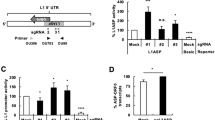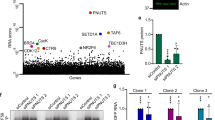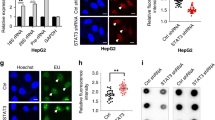Abstract
Adenovirus (Ad) E1A proteins are transcriptional regulators with antioncogenic but also transforming properties. We have previously shown that transformation-defective Ad5 E1A-derivatives are excellent tumor suppressors. For tumor-specific expression of the E1A-derivatives we intend to use tumor specific human telomerase reverse transcriptase (hTERT) core promoters. Here, we show that Spm2 and other E1A proteins with an intact amino terminus activated all hTERT constructs 10–20-fold in malignant tumor cells but not in primary fibroblasts, without affecting the activity of endogenous telomerase. The transcription rate in tumor cells was in the range of transcription from the SV40 promoter, which qualifies an E1A-hTERT system as a putative tumor targeting/expression system. The activation of the hTERT promoter by E1A was enhanced upon deletion of the Wilms' tumor 1 negative regulatory element and maintained high after deletion of the adjacent c-Myc-responsive E-box, demonstrating an important role of the remaining sequences that contain several Sp1-motifs. E1A-mediated hTERT activation was independent from the presence of the conserved region 3 (CR3) of E1A but dependent on E1A's binding to p300/CBP and recruitment of its histone acetyltransferase activity. Moreover, E1A-Spm2 and histone deacetylase-1 behaved as antagonists with respect to the regulation of transcription from the hTERT promoter. Overall, hTERT promoter/E1A-Spm2 systems may turn out to be excellent tools for transcriptionally targeted anticancer gene therapy.
This is a preview of subscription content, access via your institution
Access options
Subscribe to this journal
Receive 50 print issues and online access
$259.00 per year
only $5.18 per issue
Buy this article
- Purchase on Springer Link
- Instant access to full article PDF
Prices may be subject to local taxes which are calculated during checkout












Similar content being viewed by others
Abbreviations
- hTERT :
-
human telomerase reverse transcriptase
- Ad:
-
adenovirus
- HAT:
-
histone acetyltransferase
- HDAC:
-
histone deacetylase
- CR:
-
conserved region
References
Ait-Si-Ali S, Ramirez S, Barre FX, Dkhissi F, Magnaghi-Jaulin L, Girault JA, Robin P, Knibiehler M, Pritchard LL, Ducommun B, Trouche D, Harel-Bellan A . 1998 Nature 396: 184–186
Boyd JM, Subramanian T, Schaeper U, La Regina M, Bayley S, Chinnadurai G . 1993 EMBO J. 12: 469–478
Cong YS, Bacchetti S . 2000 J. Biol. Chem. 275: 35665–35668
Deng J, Kloosterbooer F, Xia W, Hung MC . 2002 Cancer Res. 62: 346–350
Dickopp A, Esche H, Swart G, Seeber S, Kirch HC, Opalka B . 2000 Cancer Gene Ther. 7: 1043–1050
Elliot G, O'Hare P . 1997 Cell 88: 223–233
Fax P, Lehmkühler O, Kühn C, Esche H, Brockmann D . 2000 J. Biol. Chem. 51: 40554–40560
Frisch SM, Mymryk JS . 2002 Nat. Rev. Mol. Cell Biol. 3: 441–452
Frisch SM, Dolter KE . 1995 Cancer Res. 55: 5551–5555
Frisch SM . 2001 Adv. Cancer Res. 80: 39–49
Frisch SM . 1991 Proc. Nat. Acad. Sci. USA 88: 9077–9081
Gallimore PH, Turnell AS . 2001 Oncogene 20: 7824–7835
Gu J, Kagawa S, Takakura M, Kyo S, Inoue M, Roth JA, Fang B . 2000 Cancer Res. 60: 5359–5364
Haley KP, Overhauser J, Babiss LE, Ginsberg HS, Jones NC . 1984 Proc. Nat. Acad. Sci. USA 81: 5734–5738
Hamamori Y, Sartorelli V, Ogryzko V, Puri PL, Wu HY, Wang JY, Nakatani Y, Kedes L . 1999 Cell 96: 405–413
Horikawa I, Cable LA, Afshari C, Barrett JC . 1999 Cancer Res. 59: 826–830
Hou M, Wang X, Popov N, Zhang A, Zhao X, Zetterberg A, Bjorkholm M, Henriksson M, Gruber A, Xu D . 2002 Exp. Cell. Res. 274: 25–34
Kilian A, Bowtell DD, Abud HE, Hime GR, Venter DJ, Keese PK, Duncan EL, Reddel RR, Jefferson RA . 1997 Hum. Mol. Genet. 6: 2011–2019
Kirch HC, Flaswinkel S, Rumpf H, Brockmann D, Esche H . 1999 Oncogene 29: 2728–2738
Komata T, Kondo Y, Kanzaba T, Hirohata S, Koga S, Sumiiyoshi H, Srinivazula SM, Barna BP, Germano IM, Takakura M, Inue M, Alnemri ES, Shay JW, Kyo S, Kondo S . 2001 Cancer Res. 61: 5796–5802
Komata T, Kanzaba T, Kondo Y, Kondo S . 2002 Oncogene 21: 656–663
Kyo S, Takakura M, Taira T, Kanaya T, Itoh H, Yutsudo M, Ariga H, Inoue M . 2000 Nucleic Acids Res. 28: 669–677
Mymryk JS . 1996 Oncogene 13: 1581–1589
Oh S, Song Y, Yim Y, Kim TK . 1999 J. Biol. Chem. 52: 37473–37487
Rumpf H, Esche H, Kirch HC . 1999 Virology 257: 45–53
Schuirer M, Hilger-Eversheim K, Dobner T, Bosserhoff AK, Moser M, Turner J, Crossley M, Büttner R . 2001 J. Biol. Chem. 276: 27944–27949
Shay JW, Zou Y, Hiyama E, Wright WE . 2001 Hum. Mol. Genet. 10: 677–685
Strom AC, Ohlsson P, Akusjarvi G . 1998 J. Virol. 72: 5978–5983
Sundqvist A, Bajak E, Kurup SD, Sollerbrant K, Svensson C . 2001 Exp. Cell. Res. 268: 284–293
Takakura M, Kyo S, Kanaya T, Hirano H, Takeda J, Yutsudo M, Inoue M . 1999 Cancer Res. 59: 551–557
Takakura M, Kyo S, Sowa Y, Wang Z, Yatabe N, Maida Y, Tabaka M, Inoue M . 2001 Nucleic Acids Res. 29: 3006–3011
Turner J, Crossley M . 2001 Bioessays 23: 683–690
Van Groningen JJM, Cornelissen IMAH, van Muijen GNP, Bloemerts HPJ, Swart GWM . 1996 Biochem. Biophys. Res. Comm. 225: 808–816
Van Muijen GN, Cornelissen LM, Jansen CF, Figdor CG, Johnson JP, Brocker EB, Ruiter DJ . 1991 Clin. Exp. Metastasis 9: 259–272
White E . 2001 Oncogene 20: 7836–7846
Wu KJ, Grandori C, Amacker M, Simon-Vermot N, Polack A, Lingner J, Dalla-Favera R . 1999 Nat. Genet. 21: 220–224
Yoshida M, Furumai R, Nishiyama M, Komatsu Y, Nishino N, Horinouchi S . 2001 Cancer Chemother. Pharmacol. 48: S20–S26
Yu D, Suen TC, Yan DH, Chang LS, Hung MC . 1990 Proc. Natl. Acad. Sci. USA 87: 4499–4503
Zhang Q, Yao H, Fo N, Goodman RH . 2000 Proc. Natl. Acad. Sci. USA 97: 14323–14328
Acknowledgements
We like to thank A Harel-Bellan (Laboratoire Oncogenese, Differentiation et Transduction du Signal, Villejuif, France) for the pCMV-HA-HDAC-1 expression plasmid, Katrin Thiel, and Achim Sternberg for excellent technical assistance, Nicole C Bartosch for editorial support and Jan Maschke for helpful critical discussions. This work was partly supported by the IFORES program, Medical Faculty of the University of Essen, and the Joachim Kuhlmann AIDS-Foundation, Essen, Germany.
Author information
Authors and Affiliations
Corresponding author
Rights and permissions
About this article
Cite this article
Kirch, HC., Ruschen, S., Brockmann, D. et al. Tumor-specific activation of hTERT-derived promoters by tumor suppressive E1A-mutants involves recruitment of p300/CBP/HAT and suppression of HDAC-1 and defines a combined tumor targeting and suppression system. Oncogene 21, 7991–8000 (2002). https://doi.org/10.1038/sj.onc.1205965
Received:
Revised:
Accepted:
Published:
Issue Date:
DOI: https://doi.org/10.1038/sj.onc.1205965
Keywords
This article is cited by
-
Targeted antitumor effect induced by hTERT promoter mediated ODC antisense adenovirus
Molecular Biology Reports (2010)
-
HTLV-1 HBZ cooperates with JunD to enhance transcription of the human telomerase reverse transcriptase gene (hTERT)
Retrovirology (2007)
-
An oncolytic adenovirus controlled by a modified telomerase promoter is attenuated in telomerase-negative cells, but shows reduced activity in cancer cells
Journal of Molecular Medicine (2005)
-
A novel oncolytic adenovirus targeting to telomerase activity in tumor cells with potent
Oncogene (2004)



